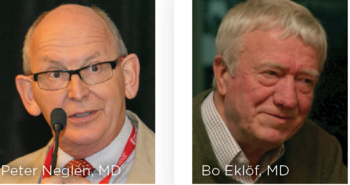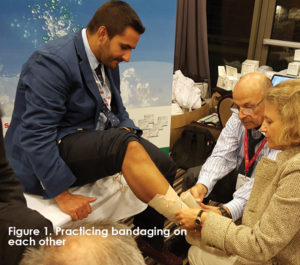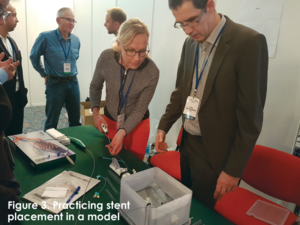by Peter Neglén, MD, PhD, and Bo Eklöf, MD, PhD

Interest in venous disease markedly increased in Europe between 2005 and 2010. Although there were several symposia, congresses, etc. organized on vascular medicine, most were centered around presentations, discussions and occasionally demonstrations on technique rather than actual hands-on training. Most of them devoted little time to venous disease.
Although workshops existed, the number of participants was low, the faculty was few, and rarely did every person put his/her hands on the devices to perform the procedure. There was an increasing need and demand for more practical instruction on management and the use of modern techniques in a comprehensive manner. To fill this need, the European Venous Forum Hands-on Venous Workshop (EVF HOW) was created. The first workshop was organized in 2010 in Larnaca, Cyprus.
This workshop fit well into the objectives of the European Venous Forum to develop and expand practical venous education. The general objectives have since been to educate, train and update participants in the current standards for clinical management of patients with venous disease. This is done by close informal interaction with venous experts during lectures, case discussions and hands-on activities in small groups. At the end of this course, the participant (delegate) should be able to:
- Identify venous disease in patients
- Apply appropriate venous investigations
- Construct a plan for management
- Understand different interventional procedures
- Successfully incorporate treatment of venous in his/her practice
- Realize when to refer a patient for expert care
“There was an increasing need and demand for more practical instruction on management and the use of modern techniques in a comprehensive manner. To fill this need, the European Venous Forum Hands-on Venous Workshop (EVF HOW) was created.”
 Although EVF realized that all venous therapists do not perform all procedures, it was (and still is) considered important that venous therapists are familiar with various interventions and their applications. The workshop therefore needs to be comprehensive and represent most types of interventions available. The academic organizing committee was familiar with the objective structured clinical examination (OSCE), where students are examined in a standardized way in a circuit of brief stations, completing them all on a controlled time schedule.
Although EVF realized that all venous therapists do not perform all procedures, it was (and still is) considered important that venous therapists are familiar with various interventions and their applications. The workshop therefore needs to be comprehensive and represent most types of interventions available. The academic organizing committee was familiar with the objective structured clinical examination (OSCE), where students are examined in a standardized way in a circuit of brief stations, completing them all on a controlled time schedule.
This concept was adapted to construct a circuit of 24 workshop stations but instead of being tested, the participants have structured hands-on training. They attend each workshop station for 30 minutes in small groups (four to five people), giving each of them time to try out varying devices, practice in bandaging one another, perform ultrasound scanning on patients, perform saphenous ablation on models, etc.
Each workshop station gives a short description of the content, and three to five objectives to be reached. At least one faculty member at each station provides the medical instruction at the station, working in collaboration with industry experts offering information about the product.
The workshops take place in a three-day span to accomplish four hours of daily hands-on instruction, which is the central activity of the workshop. The faculty also presents up-to-date information on modern practical venous disease management illustrated by case management discussions and live demonstrations. In principle, EVF HOW dedicates one day each to aspects on primary venous disease, acute thrombotic disease, and chronic post-thrombotic disease, respectively. The participants are encouraged to bring their own cases and the best presentation is awarded with a cash prize.
At the last meeting in 2016, about 30 cases were discussed during the three-day event. No more than 100 people are accepted for the workshop to ensure a very concentrated experience. With a faculty of approximately 35 instructors, an unusually high instructor-participant ratio (1:3) is ensured.
This allows intense interaction between participants and faculty in an unprecedented way, especially at the workshop stations. This communication is enhanced by allotting plenty of time for discussion, and the fact that there is no exhibition or parallel activity.
 The all-day program is very concentrated and demanding of both the participants and instructors. There is little time for extracurricular activities, and the presence of the delegates is obligatory at all learning activities. They have responded well. We have particularly been impressed by the hard work and constant input by the faculty. This is not a meeting you fly into, have a presentation, and then leave.
The all-day program is very concentrated and demanding of both the participants and instructors. There is little time for extracurricular activities, and the presence of the delegates is obligatory at all learning activities. They have responded well. We have particularly been impressed by the hard work and constant input by the faculty. This is not a meeting you fly into, have a presentation, and then leave.
EVF HOW requires a full three-day commitment, excluding travel time for each faculty member. The venous experts also share their contact information with the participants, offering them support after the meeting if they need it. Despite this, most instructors have thoroughly enjoyed EVF HOW and have been especially stimulated by the frequent interaction with the participants. The majority have returned when asked.
Success is not measured in the number of participants attending the workshop (since the attendance is limited) but rather through the quality of interaction, which is paramount. MCQ tests have been performed before and after the workshops, and usually have a response rate of approximately 90%. The results show a substantial improvement between the tests (mean increased by 35%; median increased by 50%).
In the assessment, more than 90% of learners have indicated that EVF HOW would influence and change their clinical practice in the future. These results have been similar in all seven workshops, and clearly indicate that it has had the intended impact.
“Success is not measured in the number of participants attending the workshop (since the attendance is limited) but rather through the quality of interaction, which is paramount.”
The EVF HOW associated website was introduced in 2013. This is a web-based, password-protected portfolio. Each participant who attends the workshop has access to the presentations, important references and guidelines, case reports for discussion, procedure videos, supplementary information about the workshop stations, and other study material. Access is available for one year after the workshop.
This enables participants to review, reinforce, and enhance their learning experience. The response has been extremely positive. Most of them (80%) used the website before the start of the workshop, and as many as 85% accessed it during the event—94% of these were up to 30 visits.
In the assessment, all participants fully or partially agreed that the website was a valuable support tool, especially by giving access to the presentations online, having references and guidelines in PDF format available, and the ability to return to posted video material. The applications, MCQ-tests and course assessments are now incorporated into this website and performed online. The EVF HOW also has a presence on Facebook and Twitter.
During the early EVF HOW workshops, participants frequently asked for more in-depth instruction about the details of various procedures in clinical practice. Therefore, the advanced EVF HOW Plus courses were created in 2015 to offer an opportunity to improve various skill sets for venous therapists. Participants should preferably have attended EVF HOW to be accepted.
The main objective of these in depth mini-courses is to ensure that they have sufficient skills to initiate the use of a procedure by providing detailed knowledge, and complete simulator training and preceptorship in a clinical setting.
Most courses are only two days with only four to 10 persons attending depending on the type of subject, and they often offer a chance to partake in activities at the interventional/surgical table. These courses are set up by collaborations between EVF and enthusiastic colleagues, who want to share their experience and devote time to instruction.
 For example, Drs. Marzia Lugli and Oscar Maleti in Modena, Italy have each arranged successful courses in venous stenting and deep venous valve repair, respectively. Each Plus course had four participants, who were given a chance to be scrubbed and assist in the procedures. It’s a unique event with great impact! Courses are planned for 2017 in venous stenting, deep valve repair, advanced venous ultrasounds scanning, venous ulcer treatment and early clot removal.
For example, Drs. Marzia Lugli and Oscar Maleti in Modena, Italy have each arranged successful courses in venous stenting and deep venous valve repair, respectively. Each Plus course had four participants, who were given a chance to be scrubbed and assist in the procedures. It’s a unique event with great impact! Courses are planned for 2017 in venous stenting, deep valve repair, advanced venous ultrasounds scanning, venous ulcer treatment and early clot removal.
This success of EVF HOW and EVF Plus could not have been sustained through the years without the support of dedicated faculty members and a strong commitment from industry partners. It has been a win-win situation for all involved.
The industry representatives are not only guaranteed to meet every participant, but also allowed to attend the scientific program. This is something industry representatives have greatly appreciated, as it keeps them up-to-date and allows them to participate in discussions and case presentations.
The EVF not only provides an annual scientific meeting, but also hands-on training both in a basic format with EVF HOW and more advanced training with the Plus program. We intend to develop a third step by creating a network of venous centers that allow individual venous therapists to join the instructors for a longer period for advanced training.
Although these strictly scientific meetings are important, they need complementary hands-on courses on the practical management of patients with venous disease. The industry, instructors and the participants all agree on this.
For more information, visit EVF's website here. This is the next logical step comprehensive European venous education.
- The number of participants is limited to 100 to facilitate interaction between instructors and delegates, thus making the faculty/learner ratio high (1:3)
- The hands-on sessions are truly handson for the participants, not small lectures or only procedure demonstrations
- All learning sessions are informal and in a relaxed setting that allows uninhibited communication between delegates, faculty members and industry representatives
- Plenty of time is set aside for discussion with the greatest interactions occurring at the workshop stations
- Participants are encouraged to bring their own cases for presentation and discussion
- There is no exhibition or parallel activity



